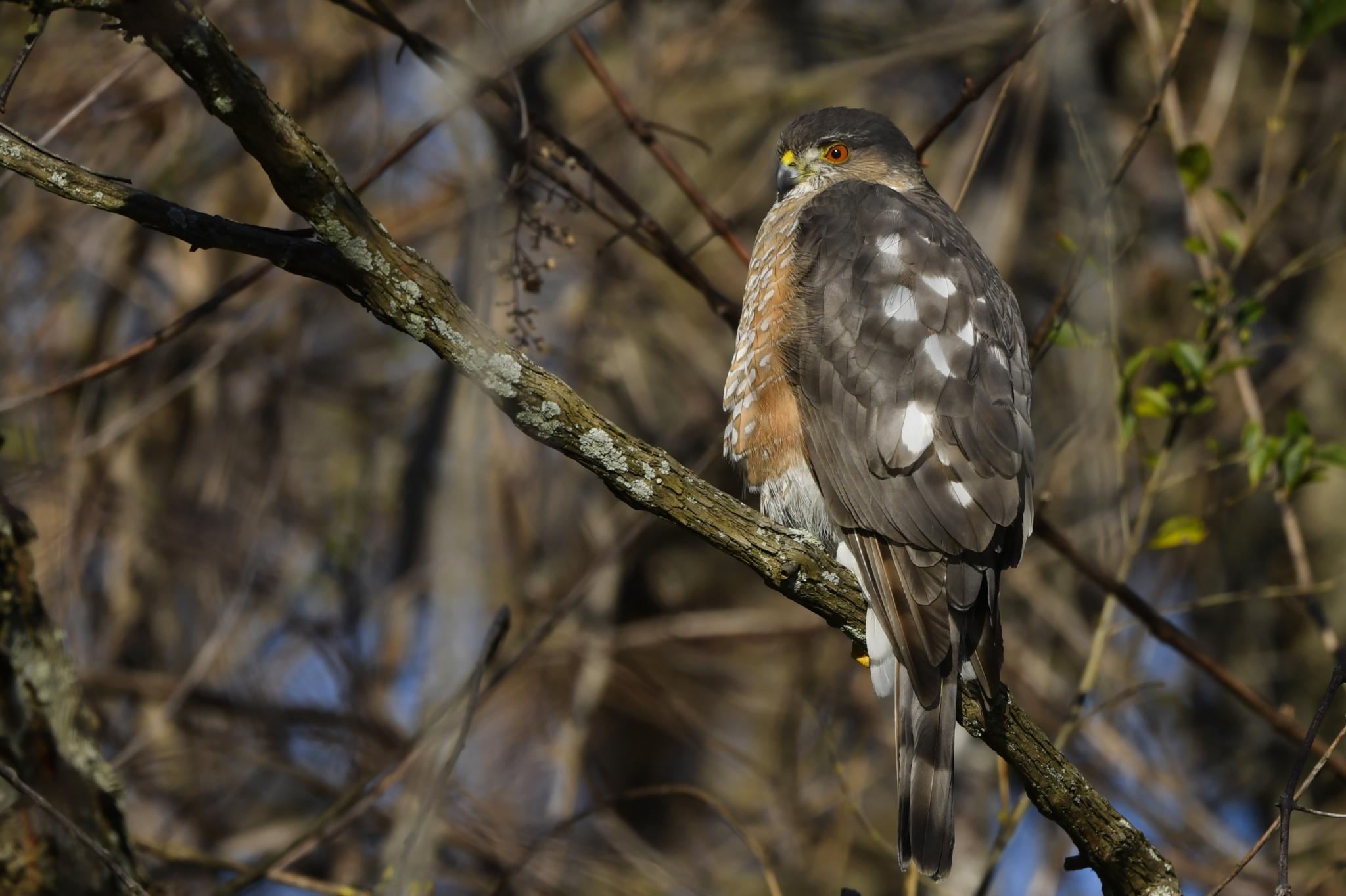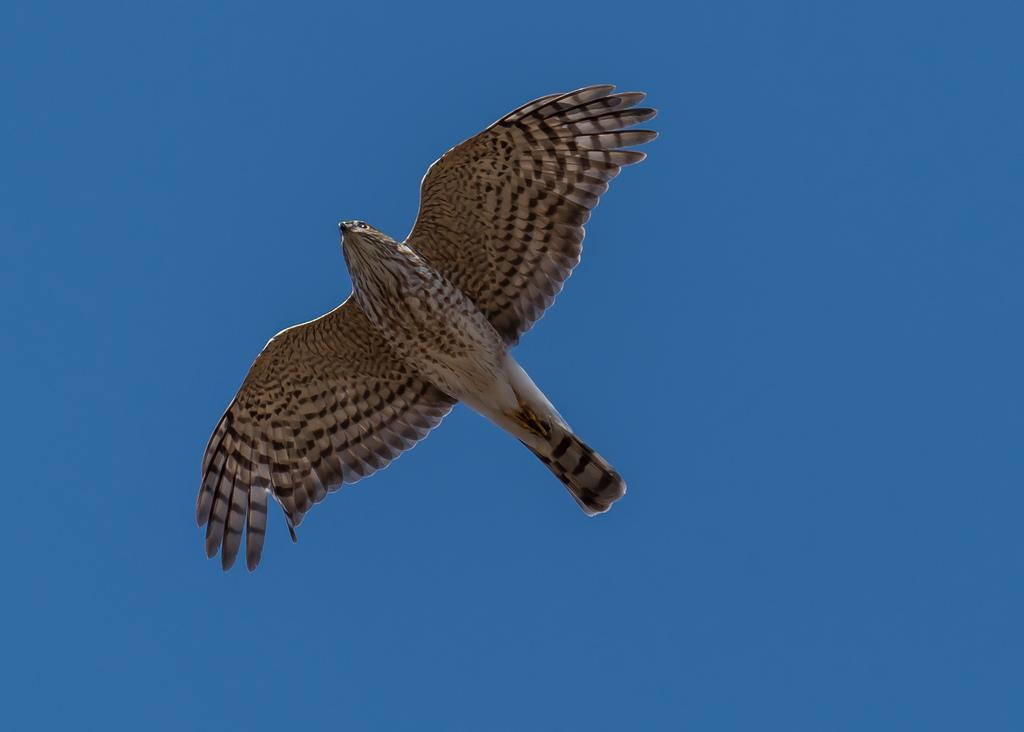
Sharp-shinned hawk, Queen Anne’s Co. Maryland. Photo by Jonathan Irons, Maryland Biodiversity Project
The sharp-shinned hawk is unlike many of the raptors that make a home in Maryland. Some, such as the osprey or the bald eagle, migrate to warmer habitats; others, such as a variety of owls and other hawks, will remain year round. The sharp-shinned hawk, apparently, does both, depending on where in the state it resides. Populations in western Maryland as well as in upland areas from New England south into the Appalachians will stay in the state throughout the year, while populations found in the central and eastern areas of the state are migratory, passing through from Canada to as far south as Central America for the winter. It is during the annual migrations that the sharp-shinned is easiest to observe, and there are a variety of “hawkwatch” sites across the eastern U.S. where observers and enthusiasts gather to watch them. Otherwise, the bird remains very elusive.
Why is it so elusive? One reason is its preferred habitat. They prefer closed woodland canopies and forest edges during the breeding and nesting season, which makes them difficult to observe. The other reason is its size. It is the smallest of North America’s “accipiter” hawks (those that prey on other birds). Other accipters, such as the Northern Goshawk and Cooper’s Hawk, are larger and, in the case of the Goshawk, will hunt the sharp-shinned. Therefore, it pays for the sharp-shinned to be somewhat reclusive.
Sharp-shinned Hawk Basics
Sharp-shinned hawk in flight, Howard Co., Maryland. Photo by Bonnie Ott, Maryland Biodiversity Project
Appearance: Adults have blue-grey back and upper wings; immature birds have browner feathers. Brown, barred chest feathers. Short, rounded wings, long tail with squared-off corners.
Size: Male 10.5 inches long; wingspan 21 inches. Females up to 30% larger
Lifespan: Unknown but oldest banded bird on record was 12 years, 2 months when found and re-released. |
As is the case with other members of the hawk family, the female sharp-shinned is up to one-third larger and heavier than the male. And as is the case with other accipiters, sharp-shinned hawks hunt birds on the wing, swooping down and capturing their prey, which are primarily birds the size of a robin or smaller, such as thrushes, warblers, and sparrows. Rather than diving down from a great height, the sharp-shinned will use cover and stealth to approach the prey and then surprise their target with a burst of speed from a hidden perch. They will then take the prey to a stump or low branch and pluck the feathers from it before eating. They have also been known to eat small rodents such as voles or mice.
The female lays a clutch of 3-8 eggs that are incubated for up to 35 days. The male, as the smaller adult, will provide food to the fledglings until they can consume the larger prey brought by the female. The adults will continue to feed the young for several weeks after they have fledged at 5-6 weeks old, to help their offspring hone their hunting skills. While the young are still in the nest, the adults will drop food for them to consume, but once the young are fledged, the adults will begin passing prey to the offspring while in flight. The adult approaches and calls to the young, which then fly up and grab the food from the adult’s talons.
For most of the year, these hawks will live alone or in pairs, particularly during nesting season. In the eastern part of North America, they prefer conifer trees for their nests, which are placed in dense cover near the tops of tall trees. The broad, flat nest is made of dead twigs, and may be lined with flakes of bark. Both male and female sharp-shinneds bring material to the nesting site, but the female does the actual construction, anchoring it between the tree trunk and horizontal tree limbs. When finished, the nest is usually 1-2 feet in diameter and 4-6 inches deep.
The female lays a clutch of 3-8 eggs that are incubated for up to 35 days. The male, as the smaller adult, will provide food to the fledglings until they can consume the larger prey brought by the female. The adults will continue to feed the young for several weeks after they have fledged at 5-6 weeks old, to help their offspring hone their hunting skills. While the young are still in the nest, the adults will drop food for them to consume, but once the young are fledged, the adults will begin passing prey to the offspring while in flight. The adult approaches and calls to the young, which then fly up and grab the food from the adult’s talons.
Populations of sharp-shinned hawks in North America suffered while DDT was in use, and some may still carry it in their bodies because of their diet of songbirds, many of which migrate from South America where the pesticide is still in use. Additionally, the species is challenged by habitat loss as the dense woodlands upon which it relies for cover, nesting, and hunting become fragmented or disappear altogether.